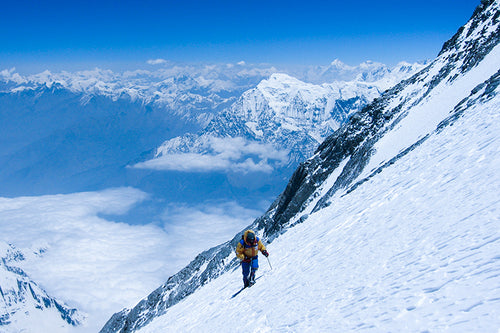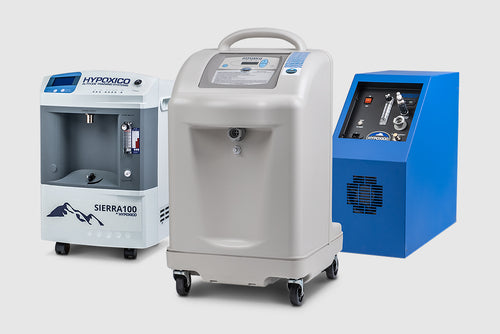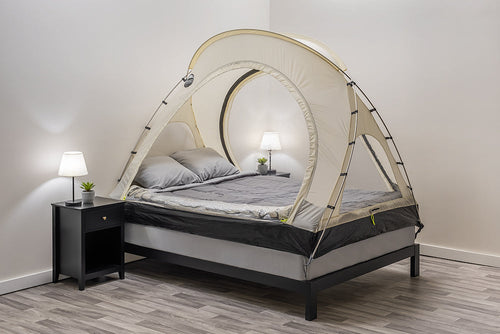
How is Less Oxygen a Good Thing?
A reduction in oxygen intake leads to a state of hypoxia, meaning oxygen in the tissues has dropped below normal levels. Because cells require oxygen to generate the energy that fuels the entire body, this presents a significant physiological challenge to overcome.
Fortunately, proteins called Hypoxia Inducible Factors (HIFs) respond to this stimulus by setting off a number of reactions geared toward enhancing the body’s utilization of available oxygen. This creates the ideal condition to introduce altitude training, which utilizes these reactions in order to facilitate desirable adaptations.

The Benefits
The benefits of altitude training are vast and vary depending on training method, but the following are just a few examples of what can be achieved as a result of the body’s response to hypoxia:
- Increased aerobic capacity (VO2 Max) 1-5
- Increased erythropoietin (EPO) production 3, 30, 31
- Increased lactate threshold 5, 38
- Increased mitochondrial density and production 35, 36, 37
- Reduced symptoms of acute mountain sickness (AMS) 58-64
- Reduced body weight and body fat percentage 55, 56
The Training Methods
-

Exercising at Altitude
The Benefits
The body works to overcome the immense challenge of exercise at altitude - both aerobic and anaerobic - through valuable adaptations that lead to improved performance, fitness, and health.
In addition, it allows for intensified cardiovascular exercise to be performed with a reduced load on the musculoskeletal system. This is especially useful for minimizing fitness loss after an injury.
How It’s Performed
By exercising in an altitude chamber, an exercise cubicle tent, or while wearing a training mask connected to an altitude generator.
LEARN MORE -

Sleeping at Altitude
The Benefits
Sleeping at altitude triggers an increase in erythropoietin (EPO) production, which enhances the oxygen-carrying capabilities of blood through a subsequent increase in red blood cell production and hemoglobin concentration. This adaptation results in a greater tolerance for the reduced oxygen intake experienced at high altitudes, and facilitates an improvement to aerobic performance through a Live High, Train Low routine.
Live High, Train Low
Live High, Train Low is the classic form of altitude training. It involves spending extended periods of time (generally while sleeping) in hypoxic conditions, and then performing active daytime training in normoxic (normal oxygen levels) conditions.
This allows athletes to obtain the benefits associated with increased EPO production, while also enabling them to maintain maximum intensity during exercise.
How It’s Performed
By sleeping in an altitude tent connected to an altitude generator, or in a bedroom converted to an altitude chamber.
LEARN MORE -

Alternating Altitude
The Benefits
Alternating altitude delivers an acute hypoxic stimulus in order to perform altitude training and trigger beneficial reactions while at rest. While this method is most often used in medical treatments, therapies, and breath training, it is also beneficial for mountaineers and athletes, as it will supplement the pre-acclimatization effort of sleeping at altitude and assist in rehabilitating injured athletes who cannot yet exercise.
How It’s Performed
By holding a training mask connected to an altitude generator, and then alternating between placing the mask on and off at timed intervals.
LEARN MORE
How to Choose a Training Method
Altitude training is just as individualized as any type of workout, so there is no one-size-fits-all approach. The method you choose depends on your personal goals, and it may even be advantageous to combine more than one.
To help make a decision, read the full pages on each of the training methods to learn about the specific benefits associated with them.
The Applications
-

Athletic Performance
Altitude training can improve both aerobic and anaerobic performance and fitness, allowing competitive athletes to push past the limits of what is possible under normal training conditions. It also allows traveling athletes and teams to prepare for high altitude competitions without ever leaving home base.
LEARN MORE -

Acclimatization
Acclimatization is the physiological process of adapting to the reduced oxygen intake experienced at high altitudes. Achieving this adaptation prior to departure is beneficial for anyone traveling to high altitude for any reason, as it will mitigate the symptoms of altitude sickness and reduce downtime upon arrival.
LEARN MORE -

Health & Wellness
Altitude training can be used to boost metabolism and accelerate weight loss, lower blood pressure and cholesterol, and simply improve overall health and fitness. It has also shown great potential in the treatment of many health conditions, such as diabetes, asthma, heart disease, Alzheimer's, and spinal cord injures.
LEARN MORE
Who Uses It
The world's most elite athletes and institutions recognize the immense value that hypoxia has on enhancing performance and health, which is why so many have made it an essential part of their training and research.

Altitude Training with Hypoxico
Performing altitude training by physically traveling to high altitude is logistically impractical and expensive, especially for those living at sea-level or in non-mountainous areas. Fortunately, altitude training can be performed virtually anywhere on Earth with the simulated altitude technology first patented by Hypoxico in 1995. It allows for safe, convenient, and precise altitude control in a way that is impossible to achieve in nature.
How We Simulate Altitude
At true altitude, available oxygen in the air is reduced as a result of a decrease in atmospheric pressure. This is known as hypobaric hypoxia, and simulating altitude in this way requires expensive and specialized equipment to handle the changes in air pressure. This greatly limits its practicality and applications for use.
Hypoxico systems leave the air pressure unchanged, and instead reduce the actual oxygen percentage of the air. This is known as normobaric hypoxia, and it’s achieved by drawing in ambient air, reducing the proportion of oxygen molecules, then supplying fresh, filtered hypoxic air for breathing.
While this technique for reducing available oxygen differs from how it occurs at true altitude, the number of oxygen molecules taken in per breath of air is identical, making it an excellent method for simulating altitude. Best of all, it allows high altitude to be simulated virtually anywhere and on any scale, without the downsides of pressure changes.
Our Training Systems
-

Altitude Generators
Small, portable appliances for conveniently simulating altitude virtually anywhere. They output hypoxic air up to the equivalent of 21,000ft, which can then be supplied to an altitude tent or training mask.
Shop Generators -

Altitude Tents
The Altitude Tent System uses an altitude generator to create a portable altitude chamber for sleeping or exercising. Our tents come in a variety of sizes to accommodate any bed size or space.
Shop Tents -

Training Mask
The Altitude Training Mask System uses an altitude generator to supply hypoxic air directly to a mask, allowing instant simulated transportation to the altitude of your choosing. It's perfect for nearly any home or gym workout.
Shop The Mask -

Altitude Chambers
From small workout spaces and bedroom conversions, to entire gyms and even swimming pools, we can build an altitude chamber of any size and for any use - up to the simulated equivalent of 30,000ft.
Learn More
How to Choose a Training System
When deciding between a generator-based system and an altitude chamber, the decision primarily comes down to cost, space, and desire for portability.
For most individual and home users, an altitude generator (with tent and/or mask) is ideal due to the low cost, portability, and small size.
For training facilities accommodating multiple simultaneous users, or for those who desire a seamlessly integrated experience, an altitude chamber is the better option.
FAQs
Is altitude training safe?
Altitude training using a Hypoxico system is very safe - much more so than actually traveling to high altitude. This is because your level of oxygen intake can easily be adjusted to maintain a blood oxygen saturation (SpO2) that is ideal for training. However, users with health conditions should always consult their doctor before introducing any new training or therapy method.
Is it backed by science?
Yes. There is decades of research proving the effectiveness of altitude training, and more is being conducted on a regular basis. See here to view a collection of some of these studies.
How does altitude training fit into my existing routine?
Altitude training is meant to supplement standard training, not replace it, so it can and should be incorporated into a normal workout routine. The important thing is to introduce altitude training slowly and at a dose that doesn't negatively impact your sleep and progress. Everyone has a unique reaction to hypoxia, which is something only you can determine.
Why not just live at high altitude?
Remaining at altitude indefinitely is actually a disadvantage because it prevents the ability to reach maximum physical intensity during exercise, an essential aspect of training that is only possible at oxygen-rich sea-level. Peak athletic performance and fitness is best pursued through a combination of both hypoxic and normoxic (normal oxygen levels) exercise, as each have their own unique yet complimentary benefits.
Is altitude training allowed in competition?
Yes. There are no drugs involved in altitude training, only a decrease in oxygen intake. Therefore, it cannot be considered doping and is legal in competition. Altitude training is a vital tool used by the most elite athletes to prepare for some of the world's biggest events, including the Olympics.
Is simulated altitude as effective as true altitude?
Yes. The benefits of altitude training occur as a result of a reduction in oxygen intake, and because Hypoxico systems are able to replicate the oxygen availabilty found at a range of altitudes, it is just as effective for obtaining said benefits.
Questions?
If you have any questions regarding altitude training and our systems, please don't hesitate to reach out and speak with one of our experts:


















